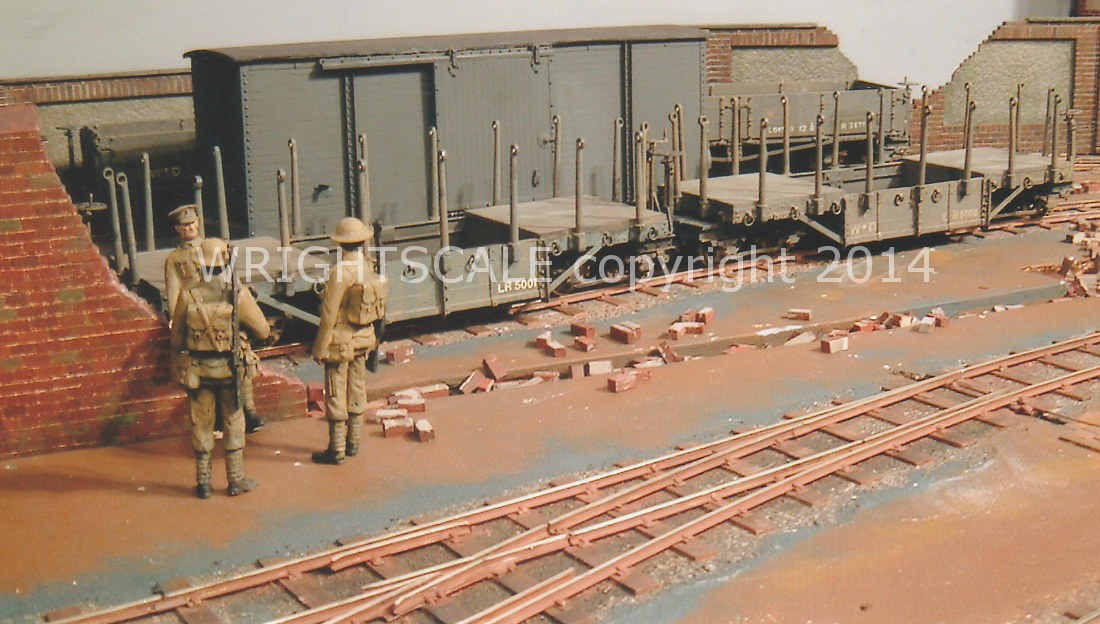 |
| 16mm model of a Bridagelok 0-8-0 with tender. Photo courtesy Jim Hawkesworth |
The paint finish, that shell into which we pour our interpretation of the scene, is true art. It was applied with care. The effect would be spoiled by big thick paint runs (that 'Dulux finish' which betrays the amateur.) The bridge and locomotive are dirty, just as real-life is dirty, oil stains and rust streaks just where you would expect them. Yet, if you look closely, this is not a miniaturisation of real life. Here, again, is real artistry. The grey is not exactly Heeresfeldbahn standard grey as specified by the German Army. You can compare it with our photos taken at the Apedale gathering which appear in a previous post. The grey Henry used is actually slightly lighter. A small coloured object must be a few tones lighter if it is to have the same impact as a large one. Further, like a tiny Parthenon, where nothing is quite as it seems, the highlights and shadows are intensified so as to provide the impact that relief would have in life size. But with the art that hides art, you won't register these effects.
We are involved and delighted with the scene - well, at least, I hope you are! We can therefore tolerate the weaknesses. The track itself isn't to the same standard as bridge and model. The colour and texture haven't been worked on. The sad fact is that Henry didn't have a chance to finish the layout. Yet, having the strong, almost alien line, taking the eye into the heart of the composition, works. It was in just the right place.
Further, if you have been following our blog, you will also notice that the buffer beams are not the right colour. The locomotives actually sported a glowing red, presumably for safety reasons. The enemy couldn't see down to the level of the buffer beams, but their own people could. But, the observer would argue, there could be an explanation for the buffer beams. Pont du Lyn is supposed to be on the Allied side of the Front and because both sides used the same gauge, it was quite common, as war ebbed and flowed, to have stock from both sides on one railway. The Allies may have acquired this locomotive during an advance and put it to work. They would have thought the red a trifle too bright and slapped a coat of British Standard Grey over it. There we are; we are so delighted with the presentation, that we find excuses and reasons for the little weaknesses. The mark of good art is a willing suspension of disbelief.
 |
| 16mm model of a Péchot-Bourdon 0-4-4-0T locomotive. Photo courtesy Jim Hawkesworth |
Ah! The figures. Absence of the human form can render any artwork, especially a layout, pointless. All too often a clumsy figure spoils it. These model people all have point. One group are standing deedily in front of the F-class wagon, seeming to be in deep discussion, but probably trying to work out where best to go for a meal. Rule number 1 for a soldier is: look busy, rule 2: locate the cookhouse.
The fireman on the Péchot-Bourdon is just looking but do not under-estimate the importance of looking. He is checking down the train. If something is wrong at this stage, it will be ten times worse down the track and in the darkness. You can see the tension in that arm. There may be something slightly cartoon-like in these little figures but it actually suits the scale. The contradictory effect is to make them more human. Art can be more life-like by being less faithful to life. The remarks above about a pale colour palette, applied highlights and shadows apply even more to figures on a layout.
Here are some more favourite views.
 |
| 16mm models of a Baldwin Gas Mechanical 50 horse power locotractor (right - a Wrightscale model built by Henry Holdsworth) and a Dick Kerr 45 h.p. Photo courtesy Jim Hawkesworth |
The Baldwin 50h.p. model is a Wrightscale production and the Dick Kerr is a special commission. Both have louvred side panels - a Westinghouse version of the 45 h.p. did not have louvres. The two locotractors were weathered by Henry. They look lovely together, part heavy carapace and part ethereal.
 |
| Some debris to clear. Wagons on Wrightscale bogies. Photo J Hawkesworth |
No comments:
Post a Comment